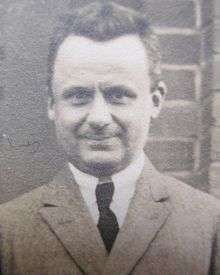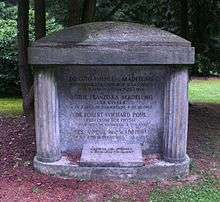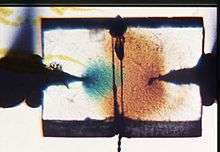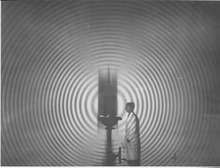Robert Pohl
| Robert Pohl | |
|---|---|
 Robert Pohl, Göttingen 1923 | |
| Born |
Robert Wichard Pohl 10 August 1884 Hamburg, German Empire |
| Died |
5 June 1976 (aged 91) Göttingen, West Germany |
| Nationality | German |
Robert Wichard Pohl (10 August 1884 – 5 June 1976) was a German physicist.
Early years and education

Robert Wichard Pohl was born in Hamburg as the son of the naval engineer Eugen Robert Pohl and his wife Martha. She was the daughter of Wichard Lange, founder of the private 'Dr. Wichard Lange School', and granddaughter of Wilhelm Middendorff, who founded the first German kindergarten, together with Friedrich Fröbel.
After completing the Dr. Wichard Lange school, Pohl entered the 'Gelehrtenschule des Johanneums' in 1895 and obtained his Abitur from it. In the summer semester of 1903, he enrolled for studies of natural science at the University of Heidelberg. There, he met James Franck, who up until Franck's death in 1964 remained a close friend. In the winter semester of 1903, Pohl transferred to the University of Berlin, where he majored in physics. Beginning in the summer semester of 1904, he had already begun scientific work in the Physics Institute with Emil Warburg on the topic which became his doctoral thesis.[1] His first publication dates from this period,[2] motivated by Bernhard Walter of the Hamburg State Physical Laboratory, where Pohl worked during his vacations, in particular attempting to observe the diffraction of X-ray radiation.[3]

Career up to the First World War
In the summer of 1906, Pohl completed his doctorate (Dr. Phil.) and took an assistantship in Berlin, working as instructor in the physics teaching labs under the Institute's director, Heinrich Rubens. He published joint articles with James Franck on ionic mobility in gases and on the propagation velocity of X-rays. From 1909, he carried out research on the normal and the selective photoelectric effect in metals, and from 1910 he worked with Peter Pringsheim,[4] on, among other things, the technically important problem of the fabrication of metal mirrors.[5] In 1910, his monograph on the remote transmission of images [6] appeared, and in 1912 he completed the Habilitation. In an addendum, his Habilitation thesis [7] contains a discussion of von Laue's discovery of X-ray diffraction.
Following his Habilitation, Pohl began giving lecture courses on experimental physics, which also motivated him to start acquiring a private collection of lecture-demonstration apparatus. He also performed demonstration experiments at the meetings of the Physical Society.[8] By the outbreak of WW I, he had published 54 scientific articles and three books.[4][6][7]
When war broke out, Pohl attempted unsuccessfully to volunteer for military service, but was refused for health reasons. His suggestion, together with Erich Regener, to set up and operate privately-funded diagnostic X-ray apparatus in two military reserve hospitals was gratefully accepted. In November 1914, he began cooperating with military radio operators on locating enemy transmission stations; this led to his appointment to a position as Chief Engineer with the rank of Captain on the Board of Transport Examiners (VPK), which he held until the end of the War.
Professorship in Göttingen
In February 1916, Pohl received the offer of an associate professorship in Göttingen (as successor to Eduard Riecke), but due to the war, he was unable to accept the position until early 1919. In his baggage for the move to Göttingen were more than 40 boxes with apparatus for his lectures. Because of the offer of a professorship at the Technical University of Stuttgart in September 1919, Pohl was promoted to Full Professor in Göttingen in December 1920 and became director of the 1st Physical Institute there. In June, 1922, he was offered a position in Würzburg, which he also refused. Thus, he was a participant in the Golden Age of physics in Göttingen during the 1920s as one of the three full professors there, along with James Franck (director of the 2nd Physical Institute) and the theoretician Max Born.
On Christmas 1922, Pohl married Tussa Madelung, the sister of Erwin Madelung, who was a research assistant in Göttingen when Tussa moved there from Strasbourg with her family in May, 1920. Robert and Tussa had three children: Ottilie, Eleonore und Robert Otto, later physics professor at Cornell University.

Photoelectric observations – however not from surfaces, as in Berlin, but rather in bulk insulators – were started by Pohl together with his assistant Bernhard Gudden in 1919. (The research work from this period was described in detail in [9](first part).) They discovered that diamond crystals become electrically conducting after irradiation with light.[10] Later, they observed the same effect in the alkali halide sodium chloride; however only after it had been colored as a result of X-ray irradiation. Systematic observations of this coloration effect using artificially-prepared crystals [11] led to the discovery of color centers, which were investigated in detail in the following years.[12] By inserting three electrodes into a potassium bromide crystal, Pohl and Rudolf Hilsch were able to demonstrate the first model of a transistor based on color centers in 1938.[13]
Alongside this research work in his own institute, Pohl collaborated with his scientific colleagues in a variety of ways. With the zoologist Alfred Kühn, he investigated the color perception of bees;[14] for the chemist Adolf Windaus, he applied optical spectroscopy to the separation of Ergosterol from Cholesterol.[15] He helped the archeologist Kurt Müller to photograph antique vases without disturbing highlights.[16] He gave active support to his student Hans Joachim Pabst von Ohain when the latter began the first experiments on jet propulsion following completion of his doctoral thesis, in the Physics Institute but privately financed.[17]
Introductory lecture courses on physics
For Pohl, the introductory lecture courses on physics were important from the very beginning; he frequently contributed new ideas for demonstration experiments, which he had developed and used in his lectures and textbooks, to the scientific literature. The first edition of his famous introductory texts in physics, his "Electromagnetism", was published in 1927. In 1930, the companion volume on "Mechanics and Acoustics" appeared, and it was extended from the third edition on to include "Thermodynamics". The third volume of the series, "Optics", was first published in 1941, and from the 9th edition in 1954 it was extended to include "Atomic Physics".

A new chapter on "Quantum Optics of Solids" summarized the research work at Pohl's Göttingen Institute. The electrical properties of solids were treated in the volume on "Electromagnetism" as well, from the 15th edition (1955) on, including the results of Pohl's work in Göttingen. After his death in 1976, the three volumes were reduced to two and these chapters were removed. In their modern form, both volumes contain DVDs or links to Internet source pages with all together 110 experiments, shown as videos, many carried out using Pohl's original apparatus.[18] Volume Two also includes a video with a biography of Pohl by Ekkehard Sieker. This DVD in addition includes a video on current amplification by a three-electrode crystal,[13] and also an audio recording of the conferral of an honorary doctorate on Ernest Rutherford in Göttingen by the Dean Max Born (1931).
The period following the Second World War; Reception of Pohl's work
Pohl's attitude towards the Nazi regime was described in his autobiographical résumé at the request of the Occupying Forces [9](second part). According to this source, he never joined a political party, and his attitude towards the National Socialists ranged from reserved to hostile; he was convinced from the beginning of the eventual defeat of Germany in the Second World War. Following the War, he was active in re-establishing the University of Göttingen, until 1948 as a member of the Denazification Commission.
The work of Pohl's Institute became internationally known only shortly before the outbreak of WW II, when Pohl and his research assistant Hilsch were invited to a conference on The conduction of electricity in solids at Bristol in 1937.[11] In 1946, the first review article on color centers appeared in the USA.[19] It resulted in 1951 in an invitation to the University of Illinois in Urbana, including visits to Bell Telephone Laboratories, the Naval Research Laboratory and other research institutes. On this occasion, Pohl once again encountered James Franck and they renewed their friendship which had been interrupted in 1933 by Franck's forced emigration.[20] In 1956, the first International Color Center Conference took place at Argonne National Laboratory; it was repeated at three-year intervals in the following years until 1977.[21]
The significance of Pohl's research at Göttingen was summarized in 1980 by the Nobel prize winner Sir Nevill Mott:[22]
"R.W. Pohl of Göttingen is in my view the real father of solid state physics."
Following his retirement in 1952, Pohl dedicated his time to improving his textbooks. In an interview with his former student Heinz Pick in 1974, he described some of his experiences at Göttingen in detail.[9]
His students and co-workers, in addition to Gudden, Hilsch and Pick, who were already mentioned, included also Erich Mollwo and Günther Glaser, and among his doctoral students was also Josef Stuke.
Honors and awards
- 1921 Member of the Göttingen Academy of Sciences
- 1928 Honorary doctorate (Dr.–Ing. e.h.) at the Technical University of Breslau
- 1935 Membership in the Leopoldina, Halle (Academy of Sciences)
- 1937 Member of the German Academy for Aeronautics Research
- 1939 Dr. h.c. at the University of Sofia
- 1945 Golden Society Medal of the Photographic Society in Vienna
- 1949 Corresponding member of the Bavarian Academy of Sciences
- 1950 Corresponding member of the Heidelberg Academy of Sciences
- 1953 Honorary Membership, American Association of Physics Teachers
- 1954 Cross of Merit (first class) of the Federal Republic of Germany
- 1957 Dr. rer. nat. h.c., Technical University of Darmstadt
- 1959 Oersted Medal of the American Association of Physics Teachers
- 1959 Dr. med. h.c. at the University of Göttingen
- 1964 Dr. rer. nat. h.c., University of Hamburg
- 1967 Cross of Merit (with star) of the Federal Republic of Germany
- 1971 Medal of Honor of the City of Göttingen
- 1975 Phillip Matthäus Hahn Medal of the German Society for Chronometry
Since 1979, the Robert Wichard Pohl Prize for experimental physics and physics didactics has been awarded annually by the German Physical Society. Also since 1979, the Robert Wichard Pohl Institute at the Tongji University in Shanghai, supported by the Volkswagen Foundation, has borne his name. A bronze memorial plaque was placed in 1995 on his former residence in Göttingen, at Klopstockstr. 4.
Textbooks
- Einführung in die Physik, Springer, Berlin (three-volume editions)
- Volume 1
- Mechanik und Akustik, (1st ed., 1930, 2nd ed., 1931)
- Mechanik, Akustik und Wärmelehre, (3rd/ 4th ed., 1941 – 18th ed. (R.O. Pohl, editor), 1983)
- Volume 2
- Elektrizitätslehre, (1st ed., 1927 – 21st ed., 1975)
- Volume 3
- Optik, (1st ed. 1940 – 8th ed., 1948)
- Optik und Atomphysik, (9th ed., 1954 – 13th ed., 1976)
- Volume 1
- Einführung in die Physik, Springer, Berlin (two-volume editions)
- Volume 1
- Mechanik, Akustik und Wärmelehre, (19th ed. (K. Lüders und R.O. Pohl, eds.), 2004; 20th ed., 2009)
- Mechanik, Akustik und Wärmelehre, (21st ed. (K. Lüders und R.O. Pohl, eds.), to be published, 2017)
- Volume 2
- Elektrizitätslehre und Optik, (22nd ed. (K. Lüders und R.O. Pohl, eds., 2006); 23rd ed., 2010; 24th ed., to be published, 2017)
- Volume 1
- Both volumes are scheduled to appear as English translations in 2017.
See also
- Pohl's Pendulum
References
- ↑ "Über die Einwirkung stiller elektrischer Entladung auf Ammoniak und Sauerstoff", R. Pohl, Verhandlungen der Deutschen Physikalischen Gesellschaft, VIII. Jahrgang Nr. 2 (1906), p. 11, and dissertation with the same title (1906)
- ↑ "Über das Leuchten bei Ionisation von Gasen. Zur Deutung der Versuche von Herrn B. Walter", R. Pohl, Annalen der Physik 4. Folge (1905), Vol. 17, p. 375
- ↑ "Weitere Versuche über die Beugung der Röntgenstrahlen", B. Walter und R. Pohl, Annalen der Physik 3. Vol. 29 (1909), p. 331
- 1 2 "Die lichtelektrischen Erscheinungen", R. Pohl und P. Pringsheim, Verlag Friedr. Vieweg & Sohn, Braunschweig 1914
- ↑ "Über die Herstellung von Metallspiegeln durch Destillation im Vakuum", Verhandlungen der Deutschen Physikalischen Gesellschaft Band 14 (1912), S. 506
- 1 2 "Die elektrische Fernübertragung von Bildern", R. Pohl, Verlag Friedr. Vieweg & Sohn, Braunschweig 1910
- 1 2 "Die Physik der Röntgenstrahlen", R. Pohl, Verlag Friedr. Vieweg & Sohn, Braunschweig 1912
- ↑ Sitzung vom 20. Nov. 1914: "… Ferner demonstriert Hr. R. Pohl einige Vorlesungsversuche". Verhandlungen der Deutschen Physikalischen Gesellschaft, 30. Nov. 1914
- 1 2 3 Biographische Notizen von Robert Wichard Pohl: "Erinnerungen an die Anfänge der Festkörperphysik in Göttingen und Lebenslauf und politische Haltung von R. W. Pohl", R. Pohl und H. Pick
- ↑ "Über lichtelektrische Leitfähigkeit von Diamanten", B. Gudden und R. Pohl, im September 1919 Zeitschrift für Physik Band 3 (1920), p. 123
- 1 2 "Zusammenfassender Bericht über Elektronenleitung und photochemische Vorgänge in Alkalihalogenidkristallen", R. Pohl, Physikalische Zeitschrift Vol. 39 (1938), pp. 36-54
- ↑ "Ein Verfahren zur Herstellung großer Kristalle", S. Kyropoulos, Zeitschrift für anorganische und allgemeine Chemie Vol. 154 (1926), p. 308
- 1 2 "Steuerung von Elektronenströmen mit einem Dreielektrodenkristall und ein Modell einer Sperrschicht", R. Hilsch und R. Pohl, Zeitschrift für Physik Vol. 111 (1938), p. 399
- ↑ "Dressurfähigkeit der Bienen auf Spektrallinien", A. Kühn und R. Pohl, Die Naturwissenschaften Vol. 9 (1921), p. 1
- ↑ "Zum optischen Nachweis eines Vitamins", R. Pohl , Die Naturwissenschaften, Vol. 15 (1927), p. 433
- ↑ "Über die Vermeidung störender Reflexe beim Fotografieren griechischer Vasen", Kurt Müller, Nachrichten von der Gesellschaft der Wissenschaften zu Göttingen, Altertumswissenschaften, Vol. II, Nr. 5 (1937), p. 103
- ↑ "Meine Liebe war die reine Physik" (PDF; 2,1 MB), Gespräch mit H. J. Pabst von Ohain, Georgia Augusta Universität Göttingen, Spektrum, Vol. 2 (1995). p. 10
- ↑ "62 seiner Experimente", R. Pohl
- ↑ "Color Centers in Alkali Halide Crystals", Federick Seitz, Reviews of Modern Physics Vol. 18 (1946), p. 384, Part II , Vol. 26 (1954), p. 7
- ↑ "James Franck – Robert Wichard Pohl, Briefwechsel 1906 – 1964", Florian Ebner, Deutsches Museum preprint, Heft 8, http://www.deutsches-museum.de/forschung/publikationen/preprint
- ↑ "Fifty years of colour centre physics", H. Pick, Journal de physique, Colloque C6, supplement au no.7, Tome 41 (1980), p. C6-1
- ↑ "Bristol Physics in the 1930s" (PDF; 28 kB), Sir Nevill Mott
External links
| Wikimedia Commons has media related to Robert Pohl. |
- Robert Pohl in the German National Library catalogue
- Pohlsches Rad
- Oral History Interview with Heinz Pick, including Pohl, AIP, 1982
- Erich Mollwo, Vor- und Frühgeschichte der Festkörperphysik in Deutschland 1992, pdf
- Interview with Robert Wichard Pohl by Thomas S. Kuhn and Friedrich Hund, June 25th 1963